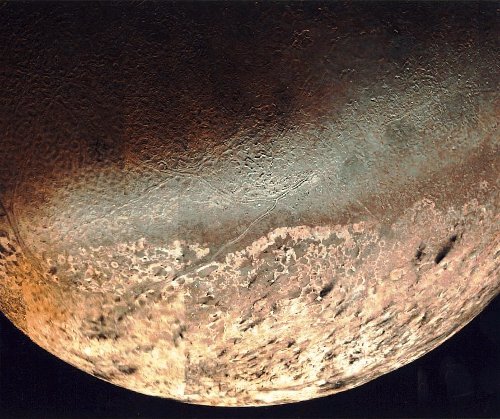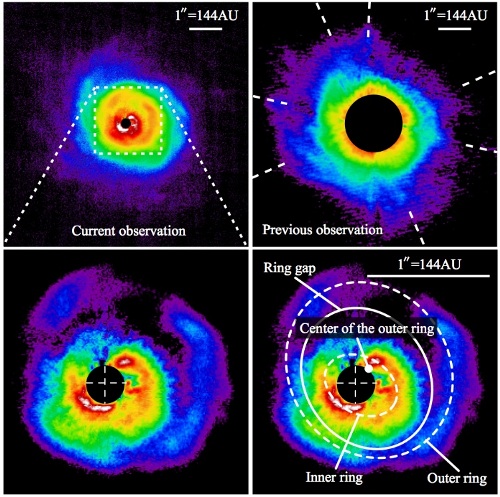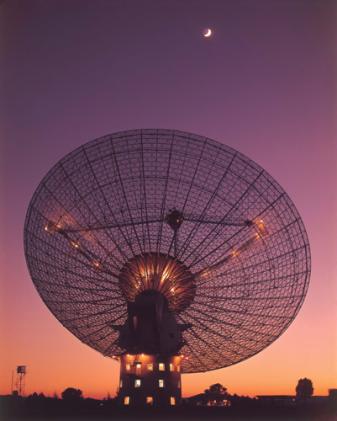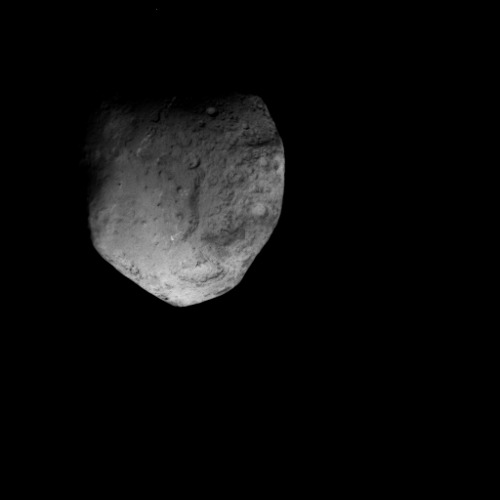Centauri Dreams
Imagining and Planning Interstellar Exploration
Water, Water, Everywhere
Our view of the Solar System has changed utterly in the last fifty years. Mention that at a cocktail party and your listener will assume you’re talking about Pluto, the demotion of which has stirred more response than any other recent planetary news. But in addition to all we’ve learned through our spacecraft, our view of the Solar System has gone from a small number of orbiting planets to huge numbers of objects at vast distances. Fifty years ago, a Kuiper Belt many times more massive than the main asteroid belt was only theory. And the early Solar System models I grew up with never included any representation of a vast cloud of comets all the way out to 50,000 AU.
We’ve also begun to learn that liquid water, once thought confined to the Earth, may be plentiful throughout the system. Caleb Scharf goes to work on this in a recent post in Life Unbounded, noting what our models are telling us about internal oceans on a variety of objects:
Much can be done with purely theoretical models that seek to determine the appropriate hydrostatic balance between an object’s own gravity and its internal pressure forces – be they from gaseous, liquid, or solid states of matter. Thermal energy from formation, and critically from radiogenic heating (radioactive decay of natural isotopes), all play a role. Throw in a few actual datapoints, measurements of places like Europa or Titan, and these models get much better calibrated. The intriguing thing is that one can play around with compositions and the internal layering of material in a planet-like body to find the best looking fit. As a consequence the nature and extent of any subsurface zones of liquid water can be estimated.
Detecting Interior Oceans
The numbers get to be striking, as Hauke Hussmann and colleagues show in a 2006 paper in Icarus. Start with Galileo, the mission to Jupiter that brought home how much we needed to modify our view of the giant planet’s moons. Galileo discovered secondary induced magnetic fields in the vicinity of Europa, Callisto and Ganymede, offering strong observational evidence for subsurface oceans on all three. The fields are thought to be generated by ions contained in the liquid water layer underneath the icy outer shells. Europa has, of course, become a prime target for future study re astrobiology thanks to the prospect of water combined with a possibly thin ice layer.
The Hussmann paper goes on to calculate interior structure models for medium-sized icy bodies in the outer Solar System, assuming thermal equilibrium between radiogenic heat produced by the core and the loss of heat through the ice shell. Now we really start expanding the picture: The paper shows that subsurface oceans are feasible not just on the now obvious case of Europa, but also on Rhea, Titania, Oberon, Triton and Pluto. A case can also be made for the Trans-Neptunian Objects 2003 UB313 , Sedna and 2004 DW. And note this:
For the bodies discussed here, the liquid layers are in direct contact with the rocky cores. This contrasts with subsurface oceans inside the large icy satellites like Ganymede, Callisto, or Titan, where they are enclosed between ice-I at the top and high-pressure ice layers at the bottom. The silicate-water contact would allow the highly efficient exchange of minerals and salts between the rocks and the ocean in the interiors of those medium-sized satellites.

Image: Triton as seen by Voyager 2. Credit: NASA.
Interestingly, given the continued examination of the moon by the Cassini spacecraft, Enceladus does not fit the Hussmann model, the paper noting that sources other than radiogenic heating would be required to sustain such an ocean, the obvious option being tidal heating. We have much to learn about Enceladus (and the paper goes into issues regarding the orbital history of the moon, and the comparison between it and Mimas, where tidal forces are much stronger). But the upshot is clear: We need more observations to confirm whether subsurface oceans are not a common phenomenon in our system’s moons and icy bodies like Trans-Neptunian Objects.
Oceans in the Outer Dark
Hussmann and colleagues assume that subsurface reservoirs on these outer worlds are located beneath a thick ice shell of more than 100 kilometers in thickness — thick enough, in fact, that there is little link between internal oceans and surface features. But study of the interaction between these internal oceans and the surrounding magnetic fields and charged particles, and the response of the objects to tides exerted by the primary, may help us to confirm whether the oceans exist. There’s work here for generations of spacecraft, but get the model right early on and we can make reasonable extrapolations about water’s ubiquity.
The paper’s model, say its authors, is not applicable to Ganymede, Callisto and Titan, but I see that Scharf’s article cites Titan as having possibly ten times the volume of Earth’s oceans in water. This is lively stuff. Quoting Scharf: “…from these bodies alone there could readily be 10 to 16 times more liquid water slurping around off-Earth than on it.” Then factor in those Trans-Neptunian Objects, add the prospect of radiogenic heating, and you wind up with at least the possibility that TNOs could be the largest source of liquid water in the entire Solar System.
Did I say our view of the Solar System has changed? This revolution continues as we push into the Kuiper Belt. New Horizons, it’s hoped, will locate a small Trans-Neptunian Object for study at some point during its journey past Pluto/Charon, but eventually we can hope for the kind of instrumentation around outer planet satellites and other objects that will help us understand their internal composition. If the prospect of internal water bears out on the kind of scales mentioned above, then we have astrobiological potential, even if faint, all the way into the Kuiper Belt.
The paper is Hussmann et al., “Subsurface oceans and deep interiors of medium-sized outer planet satellites and large trans-neptunian objects,” Icarus Vol. 185, Issue 1 (2006), p. 258-273.

New Images of Planet-Forming Disks
Protoplanetary disks present huge challenges, but we need to learn more about them to make sense of our exoplanet catalog. We’re interested in learning about the two primary theories of planet formation — core accretion from colliding bodies of rock or ice and gravitational instability in the disks themselves. But protoplanetary disks are dim compared to their central star, and our studies thus far have been more or less limited to the outer envelope of the disk structure.
What that means is that we’re looking at a scale that’s much larger than our own Solar System, not sufficient for the kind of detailed observation we’d like to make. Fortunately, we have technologies like coronagraphs, that can mask the bright light of the central star, and adaptive optics that can compensate for the blurring effects of the Earth’s atmosphere. Now we have new images from the Subaru telescope in Hawaii, which is using advanced versions of both technologies in an instrument called HiCIAO (High Contrast Instrument for the Subaru Next Generation Adaptive Optics). And our view of protoplanetary disks is becoming a bit sharper.
Consider the very young star AB Aur in the constellation Auriga, which now yields the sharpest image of a disk ever taken. You can see the result in the images below:
Image: Near-infrared (1.6 micron) images of AB Aur. The top panels compare images taken by HiCIAO and CIAO [the older instrumentation that HiCIAO replaces]. Both images have a field of view of 7.5″ by 7.5″. Top left: Image taken by HiCIAO using a coronagraphic occulting mask with a 0.3″ diameter. Top right: Image taken by CIAO using a software mask with a 1.7″ diameter. The bottom panels show close-up views of the inner part of AB Aur’s disk. Both images have a field of view of 2.0″ by 2.0″. Bottom left: Image has a coronagraphic occulting mask with a 0.3″ diameter. Bottom right: Image includes labels of its prominent features. The central position (0, 0) refers to the location of the star. Ellipsoids in dashed lines show the outer and inner rings. The solid ellipsoid indicates the wide gap between the rings. The “+” shows where the star is. The filled circle is the center of the outer ring. Credit: Subaru Telescope/SEEDS collaboration.
Here we’re looking at a developing system that is only about a million years old, located some 460 light years from Earth. The details visible in the HiCIAO images show fine details of the disk’s inner structure that are on a scale similar to Neptune’s orbit in our own Solar System. The bottom two images show close-ups of the inner disk and reveal its irregularities — note that the centers of the visible double rings do not coincide with the position of the central star. Researchers believe these irregularities point to the existence of a giant planet that is not visible because it is obscured within the disk materials themselves.
The second star under examination is LkCa 15, several million years old and roughly as massive as the Sun. The Subaru work provides the first direct imaging of a gap in the protoplanetary disk here, as shown in the following image. Again we’re looking at features on a scale similar to Neptune’s orbit, seeing a lack of material near the central star that is evidently the result of a giant planet sweeping up leftover materials from early planetary formation.
Image: High-contrast near-infrared imaging of LkCa 15 disk. The central star is hidden by the dark brown area toward the center. The inner edge of the outer disk is visible. The white feature below the blocked out area is part of the disk illuminated by the central star. The opposite side of the disk is not readily visible. There is a gap between the inner boundary of the disk and the star, at a distance of about 50 AU (Astronomical Unit, the distance between the Earth and the Sun, about 150 million kilometers or 94 million miles. Credit: Subaru Telescope/SEEDS Collaboration.
The Subaru work, which is part of the SEEDS (Strategic Explorations of Exoplanets and Disks with Subaru) Project, gives us a glimpse of the advances we’re making in direct imaging of these tricky targets. The imagery of both stars is strongly suggestive of the presence of Jupiter-class planets that are affecting the structure of the disks, yielding the useful fact that within a scant million years, giant planets can be well along the way to formation.

A Dialogue on SETI
Last October, a conference at the Royal Society looked into “the detection of life, the communication with potential extra-terrestrial civilizations, the implications for the future of humanity, and the political processes that are required.” It was a fascinating gathering, one whose results I’ve been able to study ever since thanks to Keith Cooper, who forwarded videos of a debate there on interstellar messaging (METI) and passed along transcripts of the various panels. Keith is editor of the superb Astronomy Now and is an accomplished writer on space exploration and astronomy, with over 100 articles published. I especially want to mention SETI: Cosmic Call and SETI: Terminating the Transmission in relation to what follows below.
For as Keith and I discussed these issues, it occurred to me that our correspondence in the form of a dialogue was a natural for Centauri Dreams. So here’s a slightly edited version of some recent thoughts of ours on SETI, the strength of extraterrestrial signals, and the possibility of sending return messages to the stars. Expect more in this exchange in the near future.
- Paul Gilster
Trust a Benford to get me thinking, Keith. In this case, Jim Benford, who along with brother Gregory and son Dominic, has told us so much about the feasibility of detecting and/or building interstellar beacons. As you know, I’ve written a lot about so-called ‘Benford beacons,’ fascinated with the cost constraints that the brothers have been able to establish. We have so little quantitative information to work with when it comes to SETI issues, so having an idea of how we might view beacons in terms of cost optimization was a real plus for the field.
Last week, though, I got into the question of how easy it would be to detect a signal from our Solar System. Specifically, the famous case of I Love Lucy episodes propagating out into the cosmos, and what it might take to receive them — can an extraterrestrial civilization (ETI) hope to make sense of them, or even figure out that they represent an artificial signal? And Jim’s new paper, written with John Billingham (former head of NASA’s SETI program), argues with the help of a lot of math that radio telescopes of the sort we have now couldn’t manage the task. I know you heard Jim present these results at the Royal Society meetings last October.
Image: The Parkes radio telescope in Australia. Credit: CSIRO.
Send us the Alpha Centauri equivalent of I Love Lucy, in other words, and we’ll receive nothing at all. Up the technology a bit to the level of the proposed Square Kilometer Array, operating over a wide range of frequencies and fifty times more sensitive than any radio receiving instrument we currently have, and you do manage to reach further. But even with this, we’re talking about a receiving radius less than 20 light years, and what would be at best a very low data-rate detection. So any civilization remotely at the same level as ours just isn’t going to be able to settle in to watch the Ricardos and Mertzes at all. It would be astonishing if they recognized the signal as artificial in the first place unless they already had our system under close study.
SETI implications? I think so. Back in my shortwave radio days, I used to prowl the radio dial looking for hard to detect signals from the other side of the world, and I think I always believed we would pick up ETI the same way. A chance detection, in other words, a whisper from across the stars that simply told us, for a fleeting moment, that something intelligent other than ourselves was out there in the galaxy. Now I’m thinking that scenario is more and more dubious. If Benford is right — and there are few people whose work I trust as much as Jim — then with our current state of technology, we just won’t be able to pick up any unintentional leakage at all.
Is this a rational answer to the Fermi paradox, that the stars are too widely spaced and intelligent civilizations too immature in their growth for us to be aware of each other? Or do we turn the issue around, and ask what a civilization far more advanced than ourselves would be likely to be transmitting? SETI strategy issues are much in play, and I’d be interested in your take on this latest Benford work. What do you think, Keith — is this helpful in SETI terms? And what about METI, if it turns out that we’re not quite as visible to the galaxy as we thought we were?
- Keith Cooper
You make some great points Paul, and I broadly agree with all of them. However, we must always be mindful of the assumptions that we are making, so allow me to play devil’s advocate. To highlight this, I want to briefly raise the issue of the Fermi Paradox, which you mention.
I find Fermi’s Paradox to be vastly overrated. How so? Consider what data we currently have on extraterrestrial civilisations (ETCs) – it’s a big fat nothing. We’ve closely surveyed around a 1,000 stars at water hole frequencies, briefly glanced at around a million more, but there are hundreds of billions of stars in our Galaxy. We’ve barely even begun to explore the optical, infrared or ultraviolet regimes with SETI, or search for artifacts of ET origin. So the Fermi Paradox isn’t a paradox of data, as we have none – it’s a paradox of our assumptions. It’s telling us that our assumptions are wrong, and that ET may not be as easy to find as we first thought. It’s a good springboard for new ideas, but I don’t think we should get hung up on it.
Image: Keith Cooper (left), with Michael Michaud (center) and Alexander Zaitsev, at the Royal Society conference.
Paul, you ask how all this ties into Jim Benford and John Billingham’s work and the wider issue of METI. Taken at face value it tells us that Earth remains, to all extents and purposes, invisible at radio wavelengths, and the transmissions that we have made are negligible. Our METI signals don’t even repeat – a cardinal rule in our own search. But what assumptions have Billingham and Benford made?
In this case I feel that their analogies to terrestrial technology and resources may be too strong. They assume SKA-sized radio telescopes, but who is to say that ETCs are not using something larger and more sensitive? We saw how cost optimisation led to the Benford Beacons model – a realistic viewpoint that I applaud – but here it becomes limiting. How do we know that what is expensive for us is expensive for ETCs? We really don’t know anything about their resources, or their motivations.
Furthermore, it was clear from attending the Royal Society debate that nobody could agree on the numbers. Seth Shostak, whilst agreeing that our television signals could not be detected with technology similar to ours at a distance greater than about a light year, pointed out that the Arecibo telescope could detect another Arecibo at a distance of 500 light years, while Alexander Zaitsev disagreed with Benford and Billingham’s assessment of his Cosmic Call message. So I don’t think it is clear-cut yet. Hence why Jim Benford made the call at the end of his Royal Society presentation for all transmissions from Earth to be fully documented so more thorough analyses can be made.
So there is still the risk that we could be detected, and that’s why I think there should be an international moratorium on METI until we know a little more about what is out there. Admittedly human civilisation could be detected by other means, a point of view I’m currently wrestling with, but what do you think Paul? Is it wrong to have a cautious attitude towards METI?
- Paul Gilster
I think ‘cautious’ is a reasonable attitude toward our broadcasts, Keith, but let me answer your point about extraterrestrial technology first. What you’re driving at is the great question about SETI in general. For fifty years we’ve been listening to the skies in the hopes of detecting a radio signal (and, lately, an optical signal) from a distant civilization. But now we see that radio transmission itself may be a short-lived phenomenon. Go back to the start of our earliest transmissions and you can see that we may be talking about no more than a century or so from the time our own society became radio-capable to the point where most transmissions at whatever frequency are going to be carried through cable and other non-detectable means.
So SETI is currently in a mode of intense self-examination, as you know even better than I, having attended those Royal Society meetings (lucky guy). The whole question becomes, how do we put ourselves into the minds of creatures who are by definition alien? Even if we assume they want to contact us — quite a big assumption, in my view — we still have to figure out what means they would use. Can we predict what kind of technology we’ll use for communications in a scant 100 years? Or, put a better way, can we see the shape of a future breakthrough that might change everything? Probably not. And we may be talking about a civilization that is not just a century but a millennium or, even more likely, a million years or more ahead of us.
The question of detectability has that wild card built into it. We can nail down the numbers — and Benford and Billingham have shown us some pretty hard figures for just how far out our signals are going, even if those numbers are still controversial (I see there was disagreement at the Royal Society). But if there is a risk in METI, it’s that upping our visibility in the electromagnetic spectrum might attract something we know absolutely nothing about. We’re not particularly worried, I wouldn’t think, about a civilization that builds SKAs or their equivalent — if they’re at our stage, it’s hard to see how they might present a threat to us. But that hypothetical species that’s a million years ahead of us would have all kinds of technology at its disposal for detection.
What to do? Two things come to mind. First of all, while we can make a highly educated estimate of how far our signals can be detected by a civilization like our own, I think we have to be aware that a sufficiently advanced ETI could well be aware of us at far greater distance. Alexander Zaitsev has maintained for a long time that our planetary radars would make the strongest detectable signal, although as Jim points out, the signals would be non-recurring and hard to identify. But for a civilization able to work science that is ‘indistinguishable from magic,’ even our far more routine leakage at various wavelengths might still be enough to work on.
I’m not convinced, then, that we can put the genie back in the bottle. But it’s clear that the more we transmit, and the stronger our signals become, the more likely it is that we might be detected. Cautious? Well, I’m not really worried because I suspect intelligent life is rare in the galaxy. But if I were wrong, and considering the stakes that’s an important ‘if,’ I’d want to at least do what Jim Benford recommends, which is to start documenting our electromagnetic output with exactly these issues in mind. And I think conferences like this one at the Royal Society should be expanded to bring in a wide range of disciplines, from anthropology to history, sociology and mathematics. We need many eyes on the issue, from many different backgrounds.
Here’s the problem with your moratorium, though. We’re going to be approaching the point where, absent draconian governmental measures, every company with a product to peddle or Hollywood director with a movie to sell will have more and more power to work with to try a METI broadcast. I don’t see how you stop this brightening of our EMF signature, but that’s the kind of thing I would hope people from different disciplines might kick around at future meetings.
And Keith, don’t you think figuring out alien motivations is way beyond us? It drives me crazy when people start talking about what it would be ‘logical’ for an alien species to do. We have no notion whatsoever about what might drive such a society, as Michael Michaud made clear in his talk at the Royal Society. And our only example of a technological culture is our own. How on Earth do we draw any conclusions based on that single, highly limiting sample? Have a shot at that, Keith — you can have the last word, and let’s plan on tackling Michaud’s insights in a future session, too.
- Keith Cooper
Paul, you’ve got it spot on. We don’t know anything about what life might be like out there, or how it might think or be motivated, and so allowing our assumptions (such as the idea that advanced civilisations will be inherently altruistic and happy to bestow their knowledge onto us) to be taken as fact is dangerous and limiting. Of course assumptions are all we have at present, but we have to make ourselves aware of what assumptions we’re making, and not reject alternatives out of hand. There’s an awful lot of phase space for debates on SETI and METI to explore. That’s why we need a moratorium, to give us time to discuss all those possibilities. And Paul, you might be right in saying that a moratorium may prove too difficult to enforce, but just because something is difficult doesn’t mean we shouldn’t at least try.
In 1972, Project Cyclops (page 32) recommended that:
“Before we make such a response or decide to radiate a long distance beacon, we feel the question of potential risks should be debated and resolved at national and international level.”
So what has changed? The problem is that we – the astronomical and SETI community and all interested parties – are failing to deliver a balanced debate on METI to the public. As science communicators, it’s our responsibility to present a fair and open discussion before we begin a programme of transmission. We need to avoid sensationalising it, as happened with Professor Stephen Hawking’s comments last year. If, at the end of the debate, the democratic consensus is that we should transmit, then fine. As Michael Michaud told me at the Royal Society, he would stand aside under such circumstances. We will be all the more stronger for just having the debate.
Whatever happens, the debate shouldn’t be left in the hands of just radio astronomers. It should be opened up to historians, anthropologists, social scientists, evolutionary scientists, biologists and so on, and then the public. Paul, you touched on the historical aspect, but the more I study the issues surrounding METI, the more I realise that our own history books are rocky ground.
They’re usually not written by the people involved in those historical events and frequently have skewed perspectives. For example, how many people realise that disease has been the worst enemy in contact, not swords or guns? A 1993 conference on Cultural Aspects of SETI recommended that analogies from previous contact scenarios on Earth should be used only as a rough guide for thinking, not as a roadmap of what contact with ETCs will be like. Furthermore, it also suggested that the best analogies would be ones where contact was via the transmission of ideas between cultures, rather than physical encounters, because a message from the stars is more likely than aliens actually arriving on Earth. Real world examples of this include the rediscovery of ancient Greek science, or the decipherment of Egyptian or Mayan texts. However, we should also be aware that the transmission of ideas – ‘memes’ – could be dangerous, even if their intention is well meaning. A destructive meme could spread like a virus.
I’m not saying we should never transmit Paul; one day, when we’re ready, we’ll reach out to take our place in the galactic community, if there is one. But first we have to explore the Universe more, and understand better both the intricacies of contact and, what I feel is very important, the prevalence of altruism amongst species. Should SETI discover a signal first, then it would be remiss of us not to consider replying in kind – otherwise why are we doing SETI? In such a situation we would at least have some information about the transmitting society, and we could take our time in debating and formulating a reply.
Contact with ET will be unlike any first contact that has come before in human history. We should expect the unexpected, and not rush in with our eyes closed.

Tempel 1: Close Pass, Delayed Images
We’re starting to get a look at imagery from the Stardust spacecraft’s close approach to comet Tempel 1, which occurred this morning at about 0439 UTC (2339 EST). The mission is an extension for the comet-chasing spacecraft, which flew past comet Wild 2 in 2004 and collected samples from the cometary coma that were subsequently returned to Earth. This time we’re returning to a previously visited comet, the site of the Deep Impact spacecraft’s encounter in 2005. You’ll recall that on that mission, an impactor was driven into the comet. Scientists are interested in learning what changes have occurred in the interval between visits, and possibly examining the crater.

Image: NASA’s Stardust-NExT mission transmitted the first image it took during its approach to comet Tempel 1 at 8:35 p.m. PST (11:35 p.m. EST) on Feb. 14, 2011, from a distance of approximately 2,462 kilometers (1,530 miles). The comet was first visited by NASA’s Deep Impact mission in 2005. Credit: NASA/JPL-Caltech/Cornell.
Where are the close-ups? What we know from preliminary data transmitted from the spacecraft is that the closest approach was to a distance of 181 kilometers. At about 0600 UTC, Stardust turned its high-gain antenna at the Earth and began the data downlink that should return the rest of the images later today. We’re expecting 72 images from Tempel 1, but the downloading process hasn’t gone as planned, with the images of the closest approach still aboard Stardust in a glitch that at this point doesn’t seem to threaten the loss of any data. We should know more when a NASA news conference, delayed from 1800 UTC (1300 EST), takes place later in the day.
Later: The images are coming in; here’s a sample. For more, check here.
Image: NASA’s Stardust-NExT mission took this image of comet Tempel 1 at 8:39 p.m. PST (11:39 p.m. EST) on Feb 14, 2011. Stardust-NExT is a low-cost mission that will expand the investigation of comet Tempel 1 initiated by NASA’s Deep Impact spacecraft. JPL, a division of the California Institute of Technology in Pasadena, manages Stardust-NExT for the NASA Science Mission Directorate, Washington, D.C. Joe Veverka of Cornell University, Ithaca, N.Y., is the mission’s principal investigator. Lockheed Martin Space Systems, Denver, built the spacecraft and manages day-to-day mission operations. Credit: NASA/JPL-Caltech/Cornell.

Space Technology Research Fellowships
Students interested in getting involved in space research should be aware of NASA’s Space Technology Research Fellowships. The agency is currently seeking applications from graduate students at accredited US universities for the fellowships, with a deadline for submitting fellowship proposals of 23 February. The fellowships, which are sponsored by NASA’s Office of the Chief Technologist, are available to US graduate student researchers who show ‘significant potential to contribute to NASA’s strategic space technology objectives through their studies.’
NASA Chief Technologist Bobby Braun describes the program:
“Our Space Technology Graduate Fellowships will help create the pool of highly skilled workers needed for NASA’s and our nation’s technological future, motivating many of the country’s best young minds into educational programs and careers in science, technology, engineering and mathematics. This fellowship program is coupled to a larger, national research and development effort in science and technology that will lead to new products and services, new business and industries, and high-quality, sustainable jobs. Fellowships will be awarded to outstanding young researchers and technologists positioned to take on NASA’s grand challenges and turn these goals and missions into reality.”
Complete information on the fellowships, including how to submit applications, is available here.

Toward an Interstellar Bibliography
Back when I was first thinking about writing a book on interstellar flight, my reading began with Adrian Berry’s fine study The Giant Leap: Mankind Heads for the Stars. A science writer and novelist, Berry was science correspondent for The Daily Telegraph from 1977 to 1997, and is now the paper’s Consulting Editor (Science). The Giant Leap ranged through the various propulsion options and explained the history of the interstellar idea, but I found it more inspiring still in its expression of human motivations and the urge to explore. Looking at our human history of migration and exploration, Berry liked in particular the parallel between the settlement of the Polynesian islands and our future among the stars:
It is the ‘radiative’ nature of the Polynesian voyages that provides the closest parallel to interstellar travel. It was all made possible by that forerunner of a starship, the double canoe. Imagine twin hulls about nine metres in length, covered by a single deck and a lateen sail, a craft not dissimilar to a modern catamaran… [T]hese vessels were ‘self-reproducing,’ in the sense that they were built wholly from local materials. Each time a colony settled on an island, they would cut down trees to make fresh canoes. Each of these canoes would set forth to find fresh islands, and on arriving on these, each party would eventually make fresh canoes, and so on.
It is by a method akin to this that our descendants will learn to ‘hop’ from star to star, finding suitable planets as they go, always using local materials for the construction of colonies. For migration in the future in space will be but a continuation of migration on this planet in the past, a continuing exercise of what might be called the ‘migratory imperative.’
Berry continues to explore such ideas online. The Polynesian parallel stuck with me as I began writing Centauri Dreams, and I would encounter it again in the pages of Interstellar Migration and the Human Experience (see below). But Berry’s lively book put more than a few interstellar ideas in play for me, which is why I was so pleased to learn that he recently became the Tau Zero Foundation’s largest contributor to date, donating £7000, which works out to $10,825 US. Many thanks for the support, Adrian, both financial and intellectual, that you have provided over the years.
A Bookshelf on Starflight
All of this reminds me that in what might be called the ‘hunting and gathering’ phase of writing my Centauri Dreams book, I accumulated quite a few books pertaining to interstellar flight. And because it’s part of the Tau Zero Foundation’s charter to build and maintain a list of references, it seems like a good time to post the list below. It’s very much a work in progress, one that has grown from my initial bibliography to include titles recommended to me by others (and please feel free to suggest other titles, because it’s by no means exhaustive). The division into ‘General Audience,’ ‘College Level,’ etc., is at times arbitrary but I hope it will provide at least a bit of guidance to the kind of materials available here and the range of their investigations.
- General Audience
Berry, Adrian (2000) The Giant Leap: Mankind Heads for the Stars. New Yorks: Tor Books.
A look at the technologies that might one day lead to the nearest stars and beyond. Discusses the options for making such journeys, along with the political and philosophical imperatives that might drive such a mission. Interesting chapters on interstellar navigation and suspended animation.
Boyce, Christopher (1979) Extraterrestrial Encounter: A Personal Perspective. Secaucus, NJ: Chartwell Books.
Speculations on the nature of alien intelligence and the possibilities for understanding and communicating with it. The odds on SETI and the possible use of Bracewell or von Neumann robotic probes for studying other planets play a role in this lively discussion.
Burrows, William E. Exploring Space: Voyages in the Solar System and Beyond. New York: Random House, 1990.
One of the best histories of the space program ever written, this book gives full weight to automated probes rather than manned flight, and speculates on the technologies that will take us outside the Solar System. Burrows’ look at the politics behind programs like the Space Shuttle resonates today.
Calder, Nigel (1978) Spaceships of the Mind. New York: Viking Press.
Speculations on space technologies including many interstellar concepts. Numerous useful though dated illustrations. The driving factors pushing space colonization are carefully examined.
Forward, Robert L (1995) Indistinguishable from Magic. New York: Baen Books.
Perhaps the greatest interstellar theorist of them all, Robert Forward offered mission concepts galore in the course of his career, many of them entertainingly discussed in this collection of essays. The author’s wry humor often shows through in discussions that range from wormholes to antimatter engines.
Friedman, Louis (1988) Starsailing: Solar Sails and Interstellar Travel. New York: John Wiley & Sons.
Friedman’s background working at the Jet Propulsion Laboratory on a once-considered solar sail mission to Halley’s Comet allows him to tap deep resources in explaining how solar sails will one day open up the Solar System, with potential for interstellar flight via particle or laser beam.
Kaku, Michio (2008) Physics of the Impossible: A Scientific Exploration into the World of Phasers, Force Fields, Teleportation, and Time Travel. New York: Doubleday.
Kaku discusses three levels of ‘impossibility,’ ranging from things we may one day puzzle out to technologies that would strike us as indistinguishable from magic, to use Arthur Clarke’s fine phrase. This wide-ranging study includes a look at interstellar technologies now under active study.
Krauss, Lawrence (1995) The Physics of Star Trek. New York: Basic Books.
A theoretical physicist offers thoughts on the scientific wonders of the popular TV series, discussing such issues as teleportation, time travel, warp drive and black holes. Excellent at untangling the futuristic but possible from the hugely improbable, based on known physics.
Macvey, John W. (1977, 1991) Interstellar Travel: Past, Present and Future. New York: Stein and Day.
Revised in 1991, this book examines interstellar travel technologies ranging from space arks to wormholes, with a long discussion of the nature of extraterrestrial life and how it might communicate with humans. Wide-ranging and easy to read, this is a good choice for young readers.
Myrabo, Leik and Dean Ing (1985) The Future of Flight. New York: Baen Books.
Starship drives are only one of the topics covered by this survey of future flight technologies, but the interstellar chapter is strong, surveying concepts from the Bussard ramjet to the laser-driven lightsail and antimatter engines. A good backgrounder for those wanting a quick survey of these ideas.
Nicholson, Iain (1978) The Road to the Stars. New York: William Morrow & Co.
A well-illustrated and lively survey of future space technologies, with a useful discussion of SETI and the possibilities of communicating with extraterrestrial intelligence. The major ideas for upgrading today’s engines are presented, beginning with ion drives and carrying forward to the Bussard ramjet.
Sagan, Carl (1980) Cosmos. New York: Random House.
Carl Sagan’s classic offers some of the most captivating illustrations ever made available in a space book. While the book, like the TV series it parallels, offers perspective on the entire human experience of the heavens, it places the possibilities of interstellar flight in a readable, powerful context.
Wright, Jerome L. (1992) Space Sailing. New York: Taylor & Francis.
A history of the solar sail concept, one that uses momentum from the Sun’s own light to drive a space vehicle, without the need to carry heavy fuel. Well illustrated, this book examines all the ways solar sails may change our future in space, both in the near term and the far.
- College Level
Adelman, Saul J. and Benjamin Adelman (1981). Bound for the Stars: Space Travel in our Solar System and Beyond. Inglewood Cliffs, NJ: Prentice-Hall.
The exploration of space from travel in the nearby Solar System to interstellar missions. The latter chapters discuss interstellar propulsion, navigation, the search for extrasolar planets and the first starship. Useful discussions as well about a plausible program for long-term interstellar planning.
Andreadis, Athena (1999) To Seek Out New Life: The Biology of Star Trek. New York: Three Rivers Press. A professional biologist goes to work on life sciences as depicted in Star Trek, with thoughts on everything from telepathy and the genetic code to the cultural sameness of the societies the Enterprise’s crew encounters. Entertaining and instructive.
Clarke, Arthur C., ed. (1990) Project Solar Sail. New York: Roc.
Useful essays from leading theorists examine the role of solar sails in future space missions, with attention to missions in the Solar System and beyond. The essays are interleaved with short fiction and even poetry that explores plausible scenarios for putting sails to work.
Dole, Stephen H. and Isaac Asimov (1964) Planets for Man. New York: Random House.
This is the popular version of a RAND Corporation study originally performed by Dole. The later version includes the thoughts of Isaac Asimov, and examines the factors necessary for planets to be habitable for humans, and our chances of finding them. Although dated, this book still offers useful information about the concept of a habitable zone and the factors that will one day make particular planets useful destinations for our probes.
Dyson, George (2002) Project Orion: The True Story of the Atomic Spaceship. New York: Henry Holt and Co.
Freeman Dyson’s son tackles the great attempt to wed nuclear technology to deep space missions, Project Orion. Told with flair and access not only to key documents but the recollections of the major players, this history shows how one team of experts viewed journeys to the outer Solar System and beyond before the realities of the Test Ban Treaty put the concept beyond reach.
Forward, Robert L. and Joel Davis (1988) Mirror Matter: Pioneering Antimatter Physics. New York: John Wiley & Sons.
Interstellar theorist Robert Forward offers a thorough background to the history of antimatter research. Propulsion concepts that could drive our first starships are examined, while the methods for creating and storing antimatter and using it here on Earth receive solid scrutiny. The chapter on antimatter in science fiction is particularly energetic.
Gilster, Paul (2004) Centauri Dreams: Imagining and Planning Interstellar Exploration. New York: Copernicus Books.
Surveys methods for moving an interstellar probe to speeds that could reach nearby stars in a single human lifetime. These range from fusion to antimatter, beamed lightsails, magnetic sails, Bussard ramjets and other concepts. Also covers interstellar navigation and exoplanet detection.
Kaku, Michio (1995) Hyperspace: A Scientific Odyssey Through Parallel Universes, Time Warps and the Tenth Dimension. Oxford University Press.
Understanding the possibilities of interstellar flight demands a look at the things that may warp space and time, including wormholes that could offer fast transit without exceeding the speed of light. Michio Kaku explains the options with a minimum of jargon and clear, readable prose.
Mallove, Eugene F., and Gregory L. Matloff (1989) The Starflight Handbook: A Pioneer’s Guide to Interstellar Travel. New York: John Wiley.& Sons.
A classic of interstellar studies, Matloff and Mallove’s book provides the necessary theory to understand the various propulsion methods proposed to reach the stars. All major concepts are considered by two authors who have been involved in interstellar concepts for decades.
Matloff, Gregory, Les Johnson and C. Bangs (2007) Living Off the Land in Space: Green Roads to the Cosmos. New York: John Wiley & Sons.
Space travel as we do it today requires large amounts of fuel that take up a major part of the rockets we launch. How we can learn to use resources in space itself may determine how soon we push into the outer Solar System and beyond. The science behind space tethers, solar sails and other techniques for in-System voyaging are here explored, along with speculations about even more audacious concepts that could take us to the stars.
Matloff, Gregory, Les Johnson and Giovanni Vulpetti (2010) Solar Sails: A Novel Approach to Interplanetary Travel. Berlin: Springer. A comprehensive survey of solar sail concepts ranging from near-term designs like the Solar Polar Imager to interstellar possibilities enabled by laser-driven lightsails, this book summarizes our sail knowledge at the beginning of the solar sail era, with numerous thoughts on sail design, construction, deployment and trajectories.
Savage, Marshall T. (1994) The Millennial Project: Colonizing the Galaxy in Eight Easy Steps. New York: Little, Brown & Co.
An optimistic look at how mankind can spread into the cosmos, offering a program to transfer a large proportion of the world’s population into venues off-planet. Step by step improvements lead to terraforming Mars, using the resources of the outer system, and moving to the nearby stars.
Strong, James (1965) Flight to the Stars. New York: Hart Publishing Company.
An early classic of interstellar studies, Strong’s book offers a rationale for the human expansion to the stars, while considering a variety of propulsion concepts to get the job done. While dated in specifics, the scenarios considered here paint possible futures for a star-faring race with vigor and enthusiasm.
Thorne, Kip S. (1994) Black Holes and Time Warps: Einstein’s Outrageous Legacy. New York: W.W. Norton & Co.
Thorne is a major player in the theory of wormholes, and thus the kind of distortions of spacetime that may one day make it possible to travel vast distances quickly without ever exceeding the speed of light. This book places his theories into the Einsteinian context in readable if challenging fashion.
Zubrin, Robert (1999) Entering Space: Creating a Spacefaring Civilization. New York: Tarcher/Putnam, 1999.
The case for becoming a spacefaring civilization is made with enthusiasm and panache. The action ranges from terraforming nearby Mars to exploiting the resources of the outer planets, with solid chapters on interstellar propulsion and contact with extraterrestrial civilizations.
- Graduate/Professional Level
Czysz, Paul and Claudio Bruno (2009) Future Spacecraft Propulsion Systems: Enabling Technologies for Space Exploration. Berlin: Springer.
Space propulsion systems from near-Earth to the outer Solar System and beyond. Focus on applied engineering working within the known principles of physics, with emphasis on fusion rocket designs and the extension of today’s technologies to missions into deep space.
Doody, Dave (2009) Deep Space Craft: An Overview of Interplanetary Flight. Berlin: Springer.
Descriptions of interplanetary spacecraft with detailed looks at their instrumentation and the Earth-based operations needed to acquire and process their incoming data. Flight operations and the interactions between a mission’s science team and the light team are examined, with detailed appendices on the range of instruments that have so far flown, and those likely to be aboard spacecraft in the future.
Finney, Ben R. and Eric M. Jones (1985) Interstellar Migration and the Human Experience. Berkeley: University of California Press.
This is a compilation of papers from the Conference on Interstellar Migration held at Los Alamos in May of 1983, which examined not only the scientific possibilities, but also the social, ethical and even legal ramifications of our move into the cosmos. Its look at how humanity has coped with past challenges, such as the settlement of the Pacific islands, places interstellar migration in context.
Kondo,Yoji, ed. (2003) Interstellar Travel and Multi-Generational Space Ships. Apogee Books Space Series 34. Collector’s Guide Publishing Inc (June 1, 2003).
Papers from a symposium of the American Association for the Advancement of Science in 2002, exploring propulsion concepts and the solutions needed for flight to the stars. The book also addresses the cultural and psychological issues related to long-term voyaging and ponders ‘generation ships,’ in which crew members spend their entire lives on voyages several centuries in duration.
Maccone, Claudio (2009) Deep Space Flight and Communications: Exploiting the Sun as a Gravitational Lens. Berlin: Springer.
Maccone has long been the champion of a mission to the Sun’s gravitational lens at 550 AU and beyond. Here he lays out the results of his two decades of study of the concept, discussing possible probe designs, the best targets for investigation, and the underlying principles of lensing. Section 2 examines the challenge of communicating between an interstellar spacecraft and the Earth, focusing on the opportunities found in the Karhunen-Loève Transform (KLT) for optimal telecommunications.
Matloff, Gregory L. (2005) Deep Space Probes: To the Outer Solar System and Beyond. Berlin: Springer/Praxis Books.
Recently revised, Matloff’s look at deep space technologies offers abundant references in its examination of current theories of interstellar propulsion, including nanotechnology and ramscoops that draw their fuel from hydrogen between the stars. Also included are speculations on astrobiology and the development of self-reproducing von Neumann probes that could saturate the galaxy.
Mauldin, John H. (1992) Prospects for Interstellar Travel. American Astronautical Society Science and Technology Series, Vol. 80. San Diego, CA: Univelt.
A thorough study of interstellar flight possibilities that covers, in addition to the relevant propulsion concepts, every aspect of starship design, including the navigation problem and the difficulties posed by lengthy voyages with human crews. The overall engineering of space probes designed for such missions is discussed at length, with abundant references for follow-up reading.
McInnes, Colin R. (1999) Solar Sailing: Technology, Dynamics and Mission Applications. Chichester, UK: Praxis Publishing.
The most exhaustive study of solar sail technology available, offering a rich list of references for specialists. Applications for near-term missions are considered in detail, with the relevant equations for understanding the forces at work. A thorough examination of sail materials and design explains where we are now and how solar sails may change the economics of propulsion. Beamed lightsails for interstellar missions.
Millis, Marc and Eric Davis, eds. (2009). Frontiers of Propulsion Science. Reston, VA: AIAA.
A compilation of essays from specialists about the prospects for breakthroughs that could revolutionize spaceflight and enable interstellar flight. Five major sections are included in the book: Understanding the Problem lays the groundwork for the technical details to follow; Propulsion Without Rockets discusses space drives and gravity control, both in general terms and with specific examples; Faster-Than-Light Travel starts with a review of the known relativistic limits, followed by the faster-than-light implications from both general relativity and quantum physics; Energy Considerations deals with spacecraft power systems and summarizes the limits of technology based on accrued science; and, From This Point Forward offers suggestions for how to manage and conduct research on such visionary topics.









